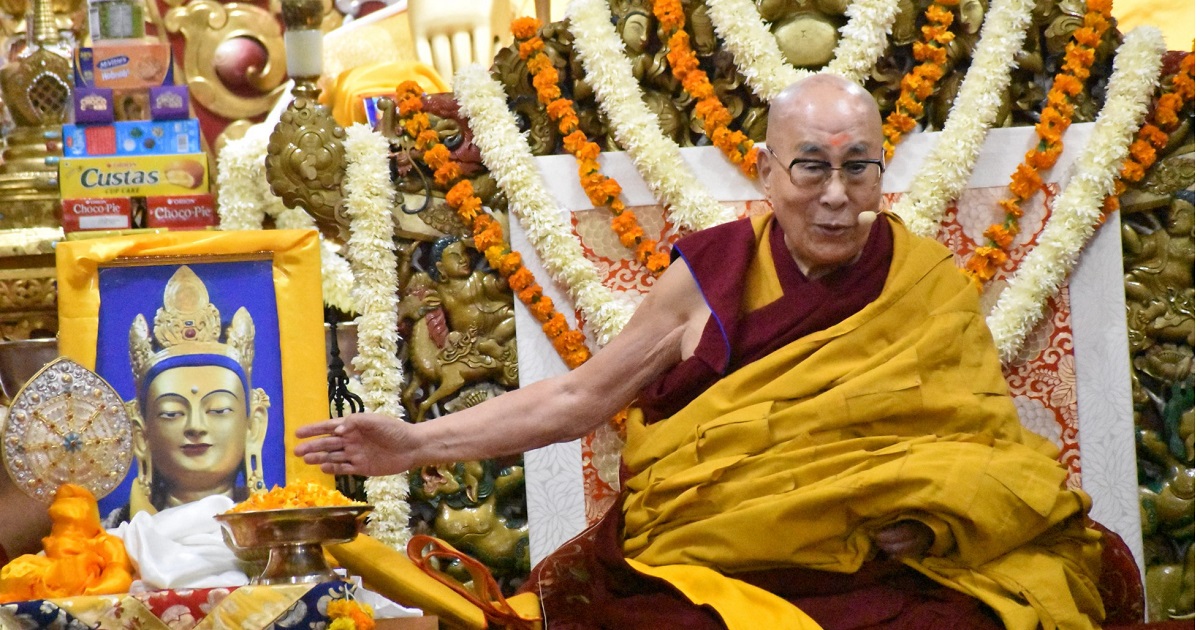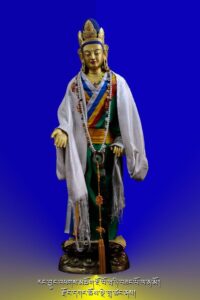
His Holiness the Dalai Lama drawing attention to the headshot of Jowo Wati Sangpo during the Long-Life Ceremony in Dharamsala on Nov. 30, 2022
The concept of Tenshug is part of our spiritual tradition. It comes from the belief that certain superior beings like His Holiness have the power to decide the course of their lifespan and their rebirth. Therefore, there is the tradition of disciples beseeching upon such lamas, through established rituals, to live long for the sake of all sentient beings. Tenshug literally means “Permanent existence.”
However, I found this statement by His Holiness intriguing as generally during such Tenshug rituals, I have seen him expressing his gratitude to the disciples for their devotion and his determination to continue serving the cause of humanity. So I tried to look into this a bit more to get some clarity on the story behind Jowo Wati Sangpo’s importance.
Jowo Wati Sangpo is believed to be a self-manifested statue of Avalokiteshvara, the Bodhisattva of Compassion, in sandalwood that appeared in the Nepal-India border region. Avalokiteshvara is known as Chenrezig in Tibetan and is regarded as the patron deity of Tibet. In fact, in Tibetan Chenrezig is referred to as Tibet’s Lhakel, “quota from among the gods.” This is because legend has it that the Buddha of Infinite Light, Amitabha, prophesied in the past that Avalokiteshvara would be the one in the future to “subdue the barbaric Land of Snows.” In his response, Avalokiteshvara committed to Amitabha, “May I have the opportunity to establish all living beings in happiness, beginning with those in the Land of Snows. Until I relieve all living beings, may I never, even for a moment feel like giving up the purpose of others for my own peace and happiness.” According to another version, Avalokiteshvara vowed to Amitabha: “If I should ever get discouraged down there, working with those barbaric Tibetans, may my body be shattered into a thousand pieces.” The Dalai Lamas are believed to be manifestations of Avalokiteshvara and therefore having a special concern for the Tibetan people.
This statue is more popularly known as Kyirong Jowo (as it came to be housed in a shrine in Kyirong in Western Tibet). The statue has a legendary beginning, believed to be part of five “Arya Brothers” statues that came into existence sometime in the seventh century. Arya is a reference to those who have attained an exalted level of practice in Buddhism. The five statues, according to Tibetan Buddhist historian Pawo Tsuklak Trengwa, are 1) Arya Wati Sangpo, also known as Kyirong Jowo; 2) Arya Bukham of Patan in Nepal; 3) Arya Akham, also of Patan in Nepal; 4) Arya Jamali of Kathmandu in Nepal; 5) Arya Lokeshvara, also known as Jowo Lokeshvara, in the Potala Palace, in Lhasa.
In the seventh century, Tibetan Emperor Songtsen Gampo, being aware of these sacred statues, wanted to bring one to Tibet for the sake of the Buddha Dharma. Legend has it that he sent a light ray from between his eyebrows carrying an emanation known as monk Akaramatiśīla (Lodoe Jungney Tsultrim Sangpo) to go to a sandalwood tree in southern Nepal and get the statue. It is said that the five statues emerged from the tree and miraculously decided on their respective future locations. Thus, two of them ended up in Tibet while the remainder three were in Nepal. One interpretation says that the statues are located along the traditional trade route from Nepal to Tibet, which begins in Patan, passing through the Kathmandu valley and reaching up to Lhasa.
In any case, while the town of Kyirong was the location of Jowo Wati Sangpo, the statue was placed in the care of the Dzongkar Choede monastery in Dzongkar, also in western Tibet, now re-established in south India. According to abbot Jampa Sopa of Dzongkar Choede, the origin of the name Wati Sangpo is traced to a water gutter or trough (In Tibetan a water trough or gutter is called “Wati” or “Wakha”). It is said that when the statue first came to Kyirong, it rested on a stone slab beside a water trough from where people would get water.
As an aside, it is said that Kyirong (“Happy town,” in Tibetan) came to be named as such because the coming of the Jowo Wati Sangpo statue brought happiness to its residents.
After the establishment of the Dalai Lama institutions, there was a special connection between them and the two statues in Tibet. For example, the fifth Dalai Lama is believed to have undertaken an Avalokiteshvara retreat and experienced visions of deities emerging from the heart of Jowo Wati Sangpo. Also, twice during the time of the Fifth and the Eighth Dalai Lamas, the statue was taken to Lhasa for safekeeping in the wake of an incursion by Nepal.
The present Dalai Lama has also talked about his own special connection to Jowo Wati Sangpo. He even calls himself a “Donyer” (chamberlain) of Wati Sangpo and talks about being at his service. During a teaching session in Yokohama in Japan on Nov. 15, 2018, he said, “That statue, the Kyirong Jowo, was brought to India by the monks of Dzongkar Chodé and is now staying with me in Dharamsala. The monks say that different expressions can be seen on its face and I’ve noticed that it seems to smile when I’m making prayers related to bodhichitta. I had a dream about it once in which I was talking to him face to face. I asked if he had realized emptiness. ‘Yes’, he replied. Some people regard the Dalai Lamas as emanations of Avalokiteshvara, but I consider myself to be just his messenger.”
Confirming the Dzongkar Choede monks’ reference to changes in the facial composure of the statue at different times, the Dalai Lama said, “When I pray to him, I feel he smiles at me. Although he can’t walk or talk, he gives me his blessing and as Chenrezig’s representative, I am determined to fulfil his wishes.”
In the wake of the Chinese invasion and occupation of Tibet, the Dzongkar Choede authorities carried out a successful plan to take the statue into exile. This included commissioning similar replacement statues, one in Kyirong itself so that no one would realize that it was no longer there, and the other one in Nepal as a way to placate the devotees who did not want the statue to go onward to India. A fascinating account of how the statue was taken out of Tibet is relayed by Lhakpa la, who was from Kyirong and entrusted with the main task then, to Voice of America’s Lhakpa Kyizom. Eventually, the statue was brought to His Holiness the Dalai Lama in Dharamsala on April 24, 1967. When the Dzongkar Choede monks were resettled in south India, His Holiness conducted a divination on the issue of the statue, which said that the statue should remain in Dharamsala. Thus, it has been in His Holiness’ residential complex. Occasionally, including during the holy month of Sagadawa (fourth month in our calendar) it is brought to the adjacent Thekchen Choling Tsuglakhang for the public to pay their obeisance.
During his address to the gathering on Nov. 30, His Holiness said while the Jowo Lokeshvara is still in the Potala, the Kyirong Jowo ended up with him in Dharamsala. He continued, “Chenrezig or Avalokiteshvara is the patron deity of Tibet and I am someone who receives his blessing. I pray every day to this Wati Sangpo. As a representative of the body, speech and mind of Avalokiteshvara I work to fulfil his wishes. And I will continue to do so for the coming decades. Since you are making these prayers and offerings on my behalf today, and since Wati Sangpo is my refuge and guardian, I’ve brought this photograph of him here with me.”
So now you know the story of the Dalai Lama and the image of Jowo Wati Sangpo.


Great Writes. One thing, I should bring up the proper wording of KyiDrong (“Happy town,” in Tibetan), Kyi= Happy, Drong = Town, instead of KyiRong. Not sure about “Rong” meaning.